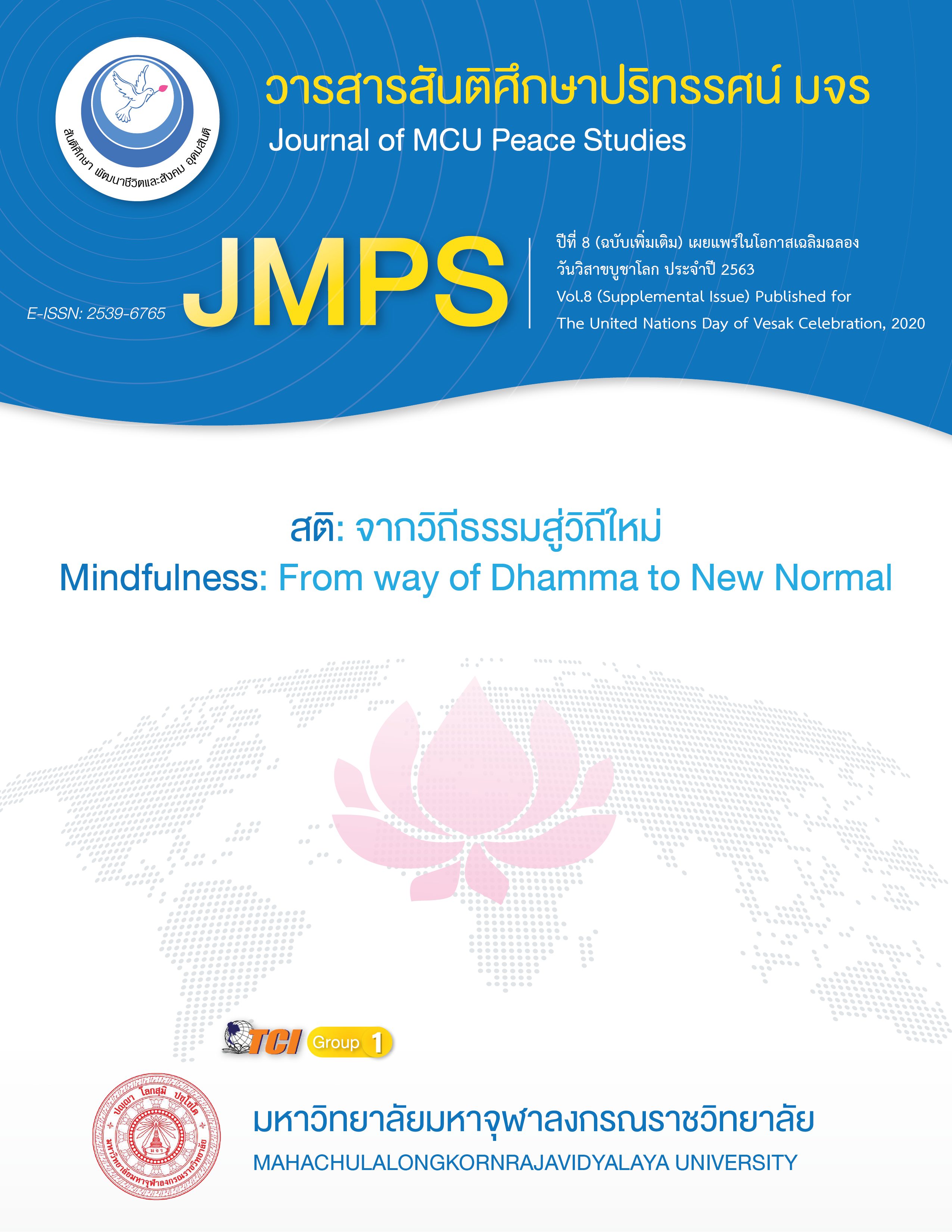การศึกษารูปแบบการจัดการเรียนรู้เพื่อส่งเสริมการคิด อย่างมีวิจารณญาณของเด็กปฐมวัย
Main Article Content
บทคัดย่อ
บทความวิจัยนี้มีวัตถุประสงค์ เพื่อศึกษารูปแบบการจัดการเรียนรู้เพื่อส่งเสริมการคิดอย่างมีวิจารณญาณของเด็กปฐมวัย เป็นการวิจัยเชิงคุณภาพ โดยการศึกษาเอกสาร งานวิจัย และใช้แบบสัมภาษณ์แบบกึ่งมีโครงสร้างสัมภาษณ์ผู้ทรงคุณวุฒิ วิธีการวิเคราะห์ข้อมูล กลุ่มตัวอย่างเป็นผู้บริหาร อาจารย์สอนนักศึกษา สาขาการศึกษาปฐมวัย จำนวน 5 คน เป็นผู้บริหารโรงเรียนโรงเรียน จำนวน 4 คน ครูสอนอนุบาล จำนวน 6 คน มีจำนวนทั้งสิ้น จำนวน 15 คน
ผลการวิจัยพบว่า รูปแบบการจัดการเรียนรู้เพื่อส่งเสริมการคิดอย่างมีวิจารณญาณของเด็กปฐมวัย
นั้นมีรูปแบบการจัดการเรียนรู้ 7 องค์ประกอบ ได้แก่ 1) หลักการแนวคิด ปรัชญา ทฤษฎี ความเชื่อที่เป็นพื้นฐานหรือเป็นหลักของรูปแบบการจัดการเรียนรู้ 2) วัตถุประสงค์เป้าหมาย การตั้งความหวังหรือความคาดหวังว่าเมื่อผู้เรียนเรียนจบแล้วผู้เรียนจะมีคุณลักษณะเป็นไปตามความคาดหวัง 3) กระบวนการจัดการเรียนรู้ การฝึกทักษะกระบวนการคิด การจัดการ การเผชิญสถานการณ์ และการประยุกต์ความรู้มาใช้เพื่อป้องกันและแก้ไขปัญหา 4) กิจกรรมการเรียนรู้ ให้ผู้เรียนได้เรียนรู้จากประสบการณ์จริง ฝึกการปฏิบัติให้ทำได้ คิดเป็น ทำเป็น ฝึกการวิเคราะห์ ฝึกการระบุข้อตกลงเบื้องต้น ฝึกการสรุปอ้างอิง ฝึกการสังเคราะห์ และฝึกการประเมินผล 5) บทบาทของผู้เรียนและผู้สอน ผู้ดำเนินการจัดการเรียนรู้สามารถจัดบรรยากาศ สภาพแวดล้อมสื่อการเรียน และอำนวยความสะดวกเพื่อให้ผู้เรียนเกิดการเรียนรู้ และมีความรอบรู้
6) สื่อทรัพยากรในการเรียนรู้ วัสดุ เครื่องมือที่จะเป็นตัวช่วยถ่ายทอดความรู้จากแหล่งความรู้ไปยังผู้เรียน และ 7) การประเมินผลรูปแบบการจัดการเรียนรู้ การพิจารณาถึงความสามารถของผู้เรียนหลังจากที่เรียนจบไปแล้วว่าจะต้องมีความสามารถอะไรบ้าง ด้านใดบ้าง หรือมีทักษะและพฤติกรรมหลังการจัดการเรียนรู้เป็นเช่นไร
Article Details
ทัศนะและความคิดเห็นที่ปรากฏในบทความในวารสาร ถือเป็นความรับผิดชอบของผู้เขียนบทความนั้น และไม่ถือเป็นทัศนะและความรับผิดชอบของกองบรรณาธิการ ยินยอมว่าบทความเป็นลิขสิทธิ์ของวารสาร
เอกสารอ้างอิง
Chathop, S. & Chuchat. (2002). Report on Brain Training for Critical Thinking. Bangkok: Wattana Panich.
Division of Research Management and Educational Quality Assurance. (2017). Thailand 4.0 Blueprint, A model drives Thailand towards stability, prosperity, and sustainability. Bangkok: Division of Research Management and Educational Quality Assurance. Retrieved August 19, 2017 from http://www.libarts.up.ac.th/v2/img/Thailand-4.0.pdf.
Duron.R. Limbach. B. & Waugh. W. (2006). Critical Thinking Framework for Any Discipline. International Journal of Teaching in Higher Education. 17 (2), 160-166.
Education Act B.E.1999. Amendment (Version 2) B.E. 2002 and (Version 3) B.E. 2010. (1999) Bangkok: The Secretariat of the Council of Education. Retrieved December 5, 2017 from https://person.mwit.ac.th/01Statutes/NationalEducation.pdf
Ennis, R. H. (1967). A Concept of Critical Thinking: A Proposed Basis for Research in the Teaching an Evaluation of Critical Thinking Ability. Chicago: Rand McNally and Company.
Facione, P. A. Facione, N. C. (1996). The California Critical Thinking Disposition Inventory (CCTD): From A and B. Test Manual. California: California Academic Press.
Kittisak, K. (2014). The Development of B-R-A-I-N Learning Model for Promoting Critical Thinking Ability of Young Children. Ed.D. Dissertation. Srinakharinwirot University.
Office of the National Economic and Social Development Board Office of the Prime Minister. (2016). National Economic and Social Development Plan Twelfth edition B.E. 2017 – 2021. Retrieved December 5, 2017 from http://plan.bru.ac.th/wpcontent/uploads/2018/12/%E0%B9%81%E0%B8%9C%E0%B8%99%E0%B8%9E%E0%B8%B1%E0%B8%92%E0%B8%99%E0%B8%B2-12-.pdf
Panich, V. (2012). Way of learning for students in the 21st century. Bangkok: Tathata Publication Co., Ltd.
Paul, R. & Elder, L. (1993). Foundation for critical thinking. Santa Rosa. CA: Rinehart and Winston.
Photisik, U. (1999). Set to create children into a genius. Volume 5 train their children to be thinkers. Bangkok: Family Direct.
Schiever, S. W. (1991). A comprehensive approach to teaching thinking. Boston: Allyn and Bacon.
Suriyarat, P. (2013). Thinking development. (New ed). (5th ed.). Bankgkok; Chulalongkorn book center.
Wongyai, W. (2000). Curriculum development and teaching a new dimension. Bangkok: Rungrueang Printing House.


